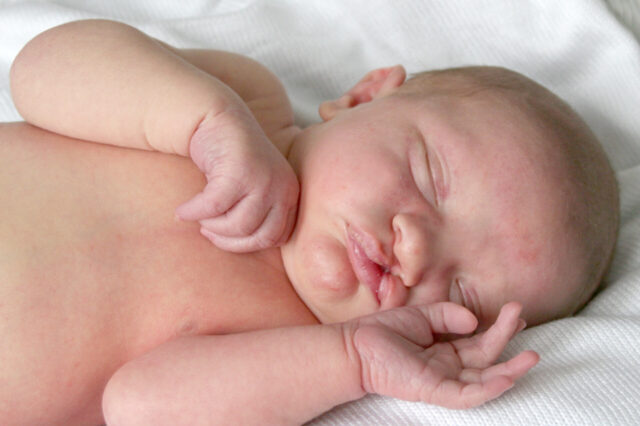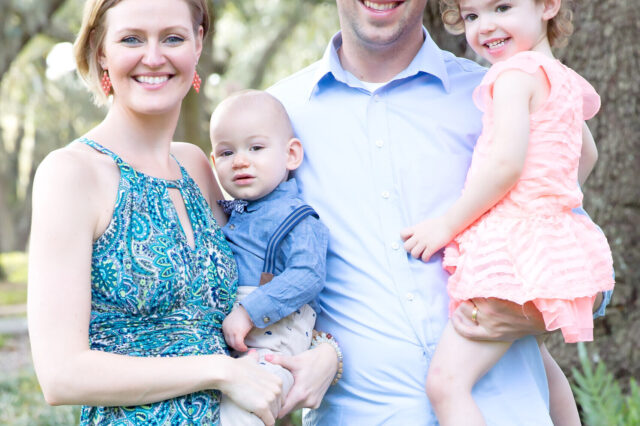The Pediatric Neurology & Neurosurgery program at UF Health Shands Children’s Hospital is ranked as one of the best programs in the nation by U.S. News & World Report.

Update your location to show providers, locations, and services closest to you.
The sutures of a baby’s skull serve as growth plates that allow the skull to grow in response to brain growth. In craniosynostosis, one or more of the sutures close early. The skull then attempts to grow parallel to the fused cranial suture, rather than perpendicular to it, causing an abnormal head shape.
The Pediatric Neurology & Neurosurgery program at UF Health Shands Children’s Hospital is ranked as one of the best programs in the nation by U.S. News & World Report.

UF Health Shands Children’s Hospital ranks among the nation’s top hospitals in four specialties.

The number of infants with head shape deformities has risen over the past several years, likely due to increased awareness of the "Back to Sleep" program. Most of the time, the head deformity is simply positional plagiocephaly, a benign condition that does not require surgical intervention. However, some deformities are caused by craniosynostosis, a condition where skull sutures fuse prematurely.
Craniosynostosis must be ruled out because it has significant medical implications. Early diagnosis and treatment of craniosynostosis improves outcomes and reduces possible adverse effects on brain development.
Occurring in one out of 2,000 to 2,500 live births, craniosynostosis may be spontaneous, syndromic, or familial and can present in many different forms. Single suture craniosynostosis is most common.
The most apparent sign of craniosynostosis is typically an abnormally-shaped head. The soft spot may be open or closed. Less common is a restriction of head growth with the measurements "falling off" the pediatrician's growth curves.
Most often, an examination of head shape can differentiate craniosynostosis from positional plagiocephaly. Head shapes are best viewed by standing above and looking down at the top of a child's head. In the case of an unclear diagnosis, a four-view skull X-ray series or head CT with 3-dimensional reconstructions of the bone windows can be used to see if sutures are fused. If the sutures are patent, then there is no craniosynostosis.
An ultra low-dose CT scan at our pediatric craniofacial center can provide 3D images at radiation doses similar to plain X-rays.
If left untreated, craniosynostosis can result in further cranial deformity and potentially an overall restriction in head growth, with secondary increased intracranial pressure. It can also lead to psychosocial issues as the child interacts with peers during development. Multiple types of surgical intervention for craniosynostosis exist.
Connecting patients with a pediatric craniofacial center as early as possible is essential as it allows all options to be offered.






In most infants, the cause of primary craniosynostosis is unknown and the child is otherwise healthy. Risk factors for craniosynostosis includes:
While the majority of cases (approximately 82 percent) are not syndromic or familial, craniosynostosis can be a feature of many different genetic syndromes. Secondary craniosynostosis can sometimes occur in children with a ventriculoperitoneal (VP) shunt (Plast Reconstr Surg 147:1390, 2021).
It is important for the child to be examined carefully for signs of an inherited genetic disorder, such as facial anomalies, limb defects, cleft lip, hearing loss or cardiovascular malformations. Craniosynostosis syndromes include: Apert syndrome, Crouzon syndrome, Pfeiffer syndrome, Muenke syndrome, Saethre-Chotzen syndrome, Antley-Bixler syndrome, and frontonasal dysplasia.
The goals of craniosynostosis surgery are to unlock and reshape the bones. Historically, craniosynostosis has been treated using surgical methods that involve an incision from ear to ear and the removal, reshaping and reattachment of affected bones. However, at UF Health Shands Children's Hospital, advances in technology are allowing us to conduct more of these procedures in a minimally invasive manner.
With traditional surgery, the procedure lasts approximately four hours and is performed in conjunction with pediatric plastic surgery. A blood transfusion is often necessary. The child is typically observed overnight in the ICU and then an additional three days on the regular neurosurgical floor before discharge. Pronounced periorbital edema is normal, but generally resolves before discharge. To reduce surgical risk, this procedure is performed around the age of 6 months. Younger infants are very unlikely to experience increased intracranial pressure before then. Multiple suture and syndromic craniosynostosis cases are more frequently treated using traditional surgical techniques. Because reshaping occurs at the time of surgery, no further interventions are required.
Minimally invasive surgery involves two small incisions and the removal of only the fused suture to unlock the bones. The surgery lasts approximately one hour and rarely requires a blood transfusion. Postoperatively, the child is observed overnight on the regular neurosurgical floor and is then discharged. Usually, there is no periorbital swelling. Minimally invasive surgery produces the most successful outcomes when performed on children before the age of 6 months. With minimally invasive techniques, reshaping occurs postoperatively with the assistance of either a cranial molding helmet or implanted custom springs.
The cranial molding helmet has a hard outer shell with moldable foam on the inside. It is worn 23 hours per day until the child's first birthday. The helmet does not press the skull into shape but rather directs the growth of the skull into a more normal shape. Because the helmet relies on the high rate of skull and brain growth in the first year of life, helmet-assisted surgery should be done between 10 to 14 weeks of age. The helmet requires frequent visits to an orthotist but no additional surgery.
Stainless steel cranial expander springs are implanted after the fused suture is resected. The springs are then removed four months later. The level of spring tension is selected based on the patient's age, bone thickness and skull deformity severity. Spring-assisted surgery is performed between the ages of 3 to 6 months. The springs require a second surgery for removal but not the use of the helmet. Springs are most commonly used for sagittal synostosis.

Example of cranial molding helmet (left); Example of a skull model with cranial expander springs (right).
In some cases, when multiple sutures are fused, cranial distraction can be employed to create more intracranial volume and decrease intracranial pressure (Governale and Ching, J Craniofac Surg 33:1454, 2022). After the skull bones are unlocked, distractors are implanted spanning the bone cut. At a rate of 1mm per day, the skull bone edges are separated by turning the screw that connects them using posts that project through the skin. After 30 days, distraction osteogenesis results in 3 cm of new bone. The posts are then removed and the skin is closed in the office . Three months later, the distractors are removed at a second surgery.

Positional plagiocephaly, sometimes known as deformational plagiocephaly, is different than craniosynostosis. In positional plagiocephaly, the ear and possibly forehead on the side of the posterior flattening are displaced anteriorly, giving the baby's head a parallelogram shape. Flattening may occur on the right, left or center occiput. The occiput is the back part of the head or skull. Symmetric positional plagiocephaly can sometimes be difficult to distinguish from bilateral coronal craniosynostosis and imaging may be considered.
In positional plagiocephaly, the skull sutures are not fused. This head shape deformation, typically of the back of the head, is caused by repeated pressure to the same area. It usually develops when a child prefers to lay his or her head on the same spot. Torticollis or gross motor delay can also contribute, and these conditions may be responsive to physical therapy.
Effects of positional plagiocephaly are primarily cosmetic, as the condition does not impact brain growth or development. Positional plagiocephaly can often be treated by the child's primary care physician or medical professional. It usually does not require an appointment with a specialist; however, specialist consultation is always available if there are concerns.

Positional plagiocephaly may be prevented by regularly checking the baby’s head shape and educating parents during well visits. Strategies to prevent positional plagiocephaly include encouraging parents to do the following:
Parents should be advised to continue placing their baby on his or her back to sleep, even if the child has positional plagiocephaly. The flattening is likely to diminish as the child obtains gross motor milestones and lies on the area less. It should also be noted that after the age of 1 year, it becomes increasingly difficult to modify a child's head shape non-invasively. If head shape is not responding to traditional conservative treatment, parents can discuss the pros and cons of using physical therapy and/or helmet therapy with their pediatrician.
At UF Health Shands Children’s Hospital, every child diagnosed with a condition requiring neurosurgical expertise is cared for with an individualized treatment plan. We see patients within just a few days for non-emergency cases and within 24 hours for urgent cases.




Craniofacial deformities include birth defects in the face or head. Many people know about cleft lips and cleft palates, but that tends to be where their…

Marissa and Jon Yeatman gave birth to a healthy baby boy named Nathaniel on Feb. 9, 2018, in Tallahassee, Florida. He was their second child and made their…
